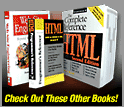











|
 |

Defining Web Design
There are five areas that cover the major facets of Web design:
| Content |
This includes the form and organization of a site's content. This can range from the way text is written to how it is organized, presented, and structured using a markup technology such as HTML. |
| Visuals |
This refers to the screen layout used in a site. The layout is usually created using HTML, CSS, or even Flash and may include graphic elements either as decoration or for navigation. The visual aspect of the site is the most obvious aspect of Web design, but it is not the sole, or most important, aspect of the discipline. |
| Technology |
While the use of various core Web technologies such as HTML or CSS fall into this category, technology in this context more commonly refers to the various interactive elements of a site, particularly those built using programming techniques. Such elements range from client-side scripting languages like JavaScript to server-side applications such as Java servlets. |
| Delivery |
The speed and reliability of a site's delivery over the Internet or an internal corporate network are related to the server hardware/software used and to the network architecture employed. |
| Purpose |
The reason the site exists, often related to an economic issue, is arguably the most important part of Web design. This element should be considered in all decisions involving the other areas. |
Of course, the amount each aspect of Web design influences a site may vary according to the type of site being built. A personal home page generally doesn't have the economic considerations of a shopping site. An intranet for a manufacturing company may not have the visual considerations of a public Web site promoting an action movie. Precisely what is meant by the expression "Web design" seems to be fluid; our discussion must take this into account, but at the same time provide ideas concise enough for the designer to keep in mind at all times. We'll start first with abstract definitions and get more concrete as we move on.
|




